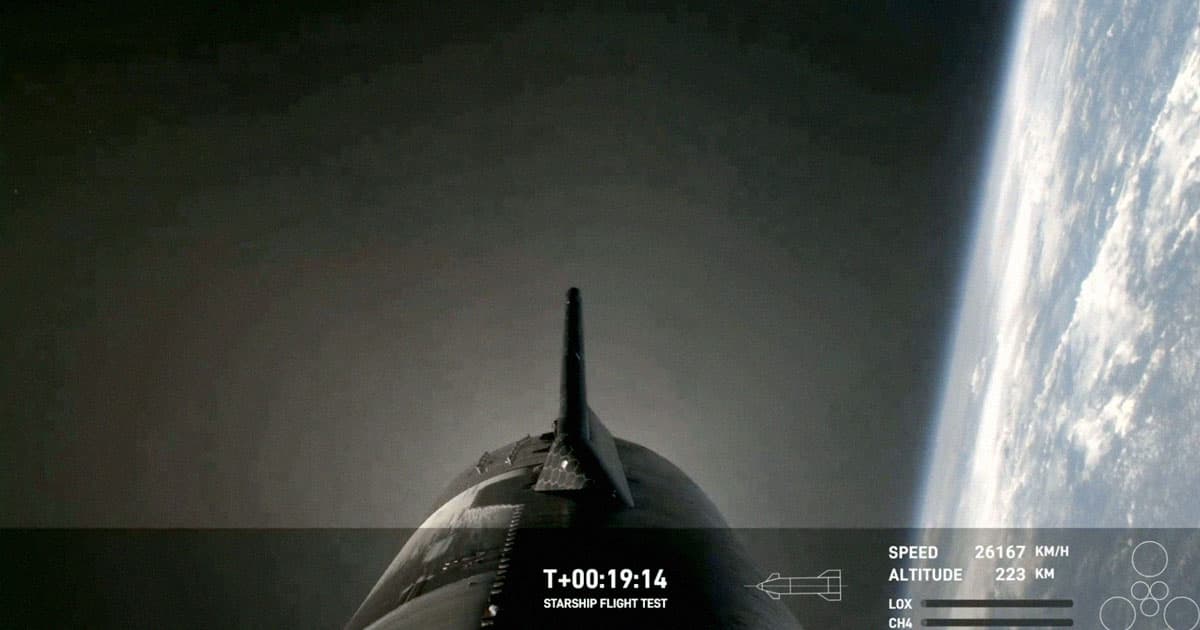The third time's the charm. Sort of.
After two spectacular explosions in April and November of last year, SpaceX's massive Starship has officially made it to space for the second time.
At first, everything appeared to go as planned, with footage showing the spacecraft gliding through the blackness of space and reaching an apogee of 145 miles, roughly 85 miles short of the International Space Station.
Its return journey, however, appears to have been a lot more harrowing, seemingly making a hard impact on the surface of the ocean.
As it turns out, SpaceX lost contact with the vehicle at an altitude of roughly 40 miles, before the spacecraft had a chance to light its engines to make a soft landing, not unlike the company's other reusable Falcon 9 rocket.
"We're making the call now that we have lost Ship 28," a ground control member announced during this morning's livestream, referring to the spacecraft's nickname.
Despite the loss of the vehicle, today's launch attempt is still a notable step forward for the company's launch system, especially compared to its past two attempts.
Harvard astronomer Jonathan McDowell, for instance, highlighted that the craft "got a lot further than Flight 2, clearly a big success overall."
Other onlookers tended to agree.
"Telemetry was not restored and they are past the expected splashdown time," SpaceNews reporter Jeff Foust tweeted. "Still a major step forward in the vehicle's development program."
Watch the super hot plasma field grow as Starship re-enters the atmosphere! pic.twitter.com/to4UOF2Kpd
— Elon Musk (@elonmusk) March 14, 2024
The 165-foot spacecraft and its Super Heavy booster roared to life earlier this morning from the company's launch site in South Texas.
"At ~5000 tons, Starship is the largest flying object ever made," SpaceX Elon Musk gloated on X-formerly-Twitter.
Footage shared by the company shows the stainless steel-clad monstrosity heating up as it re-entered the Earth's atmosphere. Another video showed the rocket "coasting in space," with the Earth slowly rotating in the background.
The largely successful launch marks a major milestone for the company's development of the reusable, super heavy-lift launch system, and could set the stage for future journeys into space, possibly including a landing on the surface of the Moon before the end of this decade.
But the company still has a lot of kinks to work out. Softly landing a 5,000 ton spacecraft on an ocean platform requires an immense amount of coordination.
The rocket also appeared to struggle to maintain its in-space attitude — basically gaining control over its considerable spin during its flight — as spaceflight communicator Eric Ralph pointed out.
It's unclear when the company will line up the next prototype for Starship's fourth orbital launch attempt. But given deadlines for its journey to the Moon are already being shifted back by NASA, it can't come soon enough.
"It’s easy to see failure," Ars Technica's Eric Berger, who has published a book about the history of SpaceX, tweeted. "If you want, go ahead. But this is failing forward at its finest."
More on Starship: Elon Musk Says Starship Will Spin for Artificial Gravity
Share This Article
